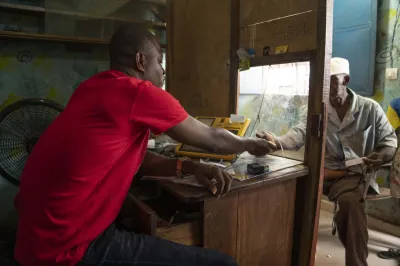The Role of Cash In/Cash Out in Digital Financial Inclusion

There’s a common assumption in the financial inclusion community that the best way to dethrone cash in emerging markets is to devise more use cases for digital financial services (DFS) that are so compelling that customers will prefer them over cash. While there is evidence that customer-centric products lead to DFS uptake and customer retention, new evidence suggests that cash-in/cash-out (CICO) networks play a critical role in a country’s transition from cash-based to fully digital financial systems. In most emerging markets, customers who want to use DFS can do so only if they’re able to convert cash into e-money and back again, as needed. In other words, the expansion of DFS among a larger clientele base depends not only on providing more attractive DFS use cases to people but also on building out broader, more convenient CICO networks that enable more people to start using DFS.
Global data show that an increase in digital finance transactions does not automatically translate into a reduction in the use of cash, which means CICO remains important as countries start to digitize. A 2018 study from BIS shows that, in fact, aggregate cash and digital payment transactions have been growing side by side in most countries around the world. A look at the global data on card transactions is telling, because card data are the most consistent digital payments across countries. The BIS chart on the left below shows that as digital transaction volumes rose from 2000 to 2016, the average value of those transaction fell. This reflects the spread of digital payments in emerging markets. At the same time, the chart on the right shows that cash demand in these emerging markets increased during the same period.
Growth of Cash Demand and Card Use

Looking closer at this global data we see a nonlinear relation between CICO infrastructure, such as agents, ATMs and bank branches, and DFS expansion. The BIS study describes how CICO infrastructure has expanded in emerging markets where DFS is growing rapidly from a lower base. In contrast, CICO infrastructure has plateaued in markets with more advanced DFS ecosystems, where there is less need to switch between cash and e-money because there are more digital use cases. In these places, such as the United Sates and most of the European Union, the share of digital transactions continues to grow even as CICO points have tapered off. Finally, there are a few countries — like China, Norway and Sweden — where CICO infrastructure has actually decreased as DFS grows. In these places, CICO points have become unnecessary for most people since all or most of their income and expenditures transactions are now digital.
The Importance of CICO Growth in Developing DFS Markets
This cross-country evidence suggests that CICO networks expand, plateau and decrease as digital financial markets develop. Additional studies show that CICO networks cause the initial expansion of DFS uptake and use. A 2018 study by Mexico’s central bank shows that the expansion of banking correspondents has caused an increase in uptake and use of bank accounts. A 2016 study by Tavneet Suri and William Jack shows that CICO agents are driving mobile money uptake in Kenya. And CGAP’s own research shows that CICO agent proximity to customers has been important for mobile money use in seven countries in Africa and Asia. These studies suggest that as the first cohort of digital finance products start digitizing part of peoples’ financial transactions, CICO points are necessary to get more people to use and to get familiar with them without disrupting their many other cash transactions.
Research by Radcliffe and Voorhies (2013), CPMI (2016), GSMA (2018) and CGAP (2018) provide some explanation on how this happens. Taken together, these studies suggest that if customers digitize part of their income (whether agricultural payments, government transfers or remittances), they need effective cash-out points so that they can conduct expenditure transactions for which there is not yet a good digital use case. Similarly, customers who are paid in cash need cash-in points to start spending digitally (airtime, transfers, bill payments, etc.). New customers’ trust in an initial DFS offer is contingent on having a positive customer experience and not disrupting customers’ remaining cash transactions.
These studies suggest that a full transition to digital occurs only when both income and expense-related transactions are digitized for most people, such that their need for cash is greatly reduced. While DFS suppliers work on digitizing people’s many income- and expense-related transactions, greater reach in CICO networks enables the DFS customer base in developing financial markets to expand. This growing customer base helps DFS providers to understand customers’ needs. It also motivates investments to develop more and better digital finance products that digitize a wider array of customer transactions and reduce the need for cash. The speed with which this process happens determines how soon a country transitions away from CICO and into a fully digital financial system.
Convenient, reliable and trustworthy CICO networks play an important role in broadening and deepening DFS in developing financial markets. The expansion of CICO networks complements efforts to diversify DFS use cases that meet the needs of more low-income customers. After all, CICO points are the gateway for new customers to start using DFS in emerging markets.
For more on the role of CICO agents in digital financial inclusion and recomendations on how funders, policy makers and financial services providers can expand CICO networks to more of the world's poor, see "Agent Networks at the Last Mile: A Guide for Digital Finance to Reach Rural Customers" (CGAP, 2019).




Add new comment